Mitochondrial superoxide dismutase SOD2, but not cytosolic SOD1, plays a critical role in protection against glutamate-induced oxidative stress and cell death in HT22 neuronal cells
- PMID: 20060889
- PMCID: PMC2861908
- DOI: 10.1016/j.freeradbiomed.2009.12.024
Mitochondrial superoxide dismutase SOD2, but not cytosolic SOD1, plays a critical role in protection against glutamate-induced oxidative stress and cell death in HT22 neuronal cells
Abstract
Oxidative cell death is an important contributing factor in neurodegenerative diseases. Using HT22 mouse hippocampal neuronal cells as a model, we sought to demonstrate that mitochondria are crucial early targets of glutamate-induced oxidative cell death. We show that when HT22 cells were transfected with shRNA for knockdown of the mitochondrial superoxide dismutase (SOD2), these cells became more susceptible to glutamate-induced oxidative cell death. The increased susceptibility was accompanied by increased accumulation of mitochondrial superoxide and loss of normal mitochondrial morphology and function at early time points after glutamate exposure. However, overexpression of SOD2 in these cells reduced the mitochondrial superoxide level, protected mitochondrial morphology and functions, and provided resistance against glutamate-induced oxidative cytotoxicity. The change in the sensitivity of these SOD2-altered HT22 cells was neurotoxicant-specific, because the cytotoxicity of hydrogen peroxide was not altered in these cells. In addition, selective knockdown of the cytosolic SOD1 in cultured HT22 cells did not appreciably alter their susceptibility to either glutamate or hydrogen peroxide. These findings show that the mitochondrial SOD2 plays a critical role in protecting neuronal cells from glutamate-induced oxidative stress and cytotoxicity. These data also indicate that mitochondria are important early targets of glutamate-induced oxidative neurotoxicity.
Copyright 2010 Elsevier Inc. All rights reserved.
Figures

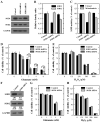
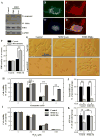
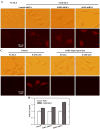
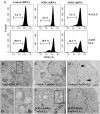
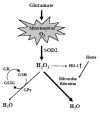
Similar articles
-
Mechanism for the protective effect of resveratrol against oxidative stress-induced neuronal death.Free Radic Biol Med. 2010 Sep 1;49(5):800-13. doi: 10.1016/j.freeradbiomed.2010.06.002. Epub 2010 Jun 8. Free Radic Biol Med. 2010. PMID: 20542495 Free PMC article.
-
Neuroprotective Mitochondrial Remodeling by AKAP121/PKA Protects HT22 Cell from Glutamate-Induced Oxidative Stress.Mol Neurobiol. 2019 Aug;56(8):5586-5607. doi: 10.1007/s12035-018-1464-3. Epub 2019 Jan 16. Mol Neurobiol. 2019. PMID: 30652267 Free PMC article.
-
Sequential Upregulation of Superoxide Dismutase 2 and Heme Oxygenase 1 by tert-Butylhydroquinone Protects Mitochondria during Oxidative Stress.Mol Pharmacol. 2015 Sep;88(3):437-49. doi: 10.1124/mol.115.098269. Epub 2015 Jun 16. Mol Pharmacol. 2015. PMID: 26082377 Free PMC article.
-
Neuroprotective effects of Dendropanax morbifera leaves on glutamate-induced oxidative cell death in HT22 mouse hippocampal neuronal cells.J Ethnopharmacol. 2020 Apr 6;251:112518. doi: 10.1016/j.jep.2019.112518. Epub 2019 Dec 26. J Ethnopharmacol. 2020. PMID: 31884031
-
Mitochondrial function and energy metabolism in neuronal HT22 cells resistant to oxidative stress.Br J Pharmacol. 2014 Apr;171(8):2147-58. doi: 10.1111/bph.12549. Br J Pharmacol. 2014. PMID: 24319993 Free PMC article.
Cited by
-
Transcriptomics and gut microbiome analysis of the edible herb Bidens pilosa as a functional feed additive to promote growth and metabolism in tilapia (Oreochromis spp.).BMC Genomics. 2024 Aug 13;25(1):785. doi: 10.1186/s12864-024-10674-8. BMC Genomics. 2024. PMID: 39138417 Free PMC article.
-
Therapeutic Targeting of Krüppel-Like Factor 4 and Its Pharmacological Potential in Parkinson's Disease: a Comprehensive Review.Mol Neurobiol. 2024 Jun;61(6):3596-3606. doi: 10.1007/s12035-023-03800-2. Epub 2023 Nov 24. Mol Neurobiol. 2024. PMID: 37996730 Free PMC article. Review.
-
Neuroprotective Effects of Sparassis crispa Ethanol Extract through the AKT/NRF2 and ERK/CREB Pathway in Mouse Hippocampal Cells.J Fungi (Basel). 2023 Sep 7;9(9):910. doi: 10.3390/jof9090910. J Fungi (Basel). 2023. PMID: 37755018 Free PMC article.
-
The Role of Lipoxidation in the Pathogenesis of Diabetic Retinopathy.Front Endocrinol (Lausanne). 2021 Feb 18;11:621938. doi: 10.3389/fendo.2020.621938. eCollection 2020. Front Endocrinol (Lausanne). 2021. PMID: 33679605 Free PMC article. Review.
-
A new vicious cycle involving glutamate excitotoxicity, oxidative stress and mitochondrial dynamics.Cell Death Dis. 2011 Dec 8;2(12):e240. doi: 10.1038/cddis.2011.117. Cell Death Dis. 2011. PMID: 22158479 Free PMC article.
References
-
- Coyle JT, Puttfarcken P. Oxidative stress, glutamate, and neurodegenerative disorders. Science. 1993;262:689–695. - PubMed
-
- Blandini F, Porter RH, Greenamyre JT. Glutamate and Parkinson’s desease. Mol Neurobiol. 1996;12:73–94. - PubMed
-
- Choi DW. Glutamate neurotoxicity and diseases of nervous system. Neuron. 1988;1:623–634. - PubMed
-
- Choi DW. Exitotoxic cell death. J Neurobiol. 1992;23:1261–1276. - PubMed
-
- Tan S, Wood M, Maher P. Oxidative stress induces a form of programmed cell death with characteristics of both apoptosis and necrosis in neuronal cells. J Neurochem. 1998;71:95–105. - PubMed
Publication types
MeSH terms
Substances
Grants and funding
LinkOut - more resources
Full Text Sources
Miscellaneous

